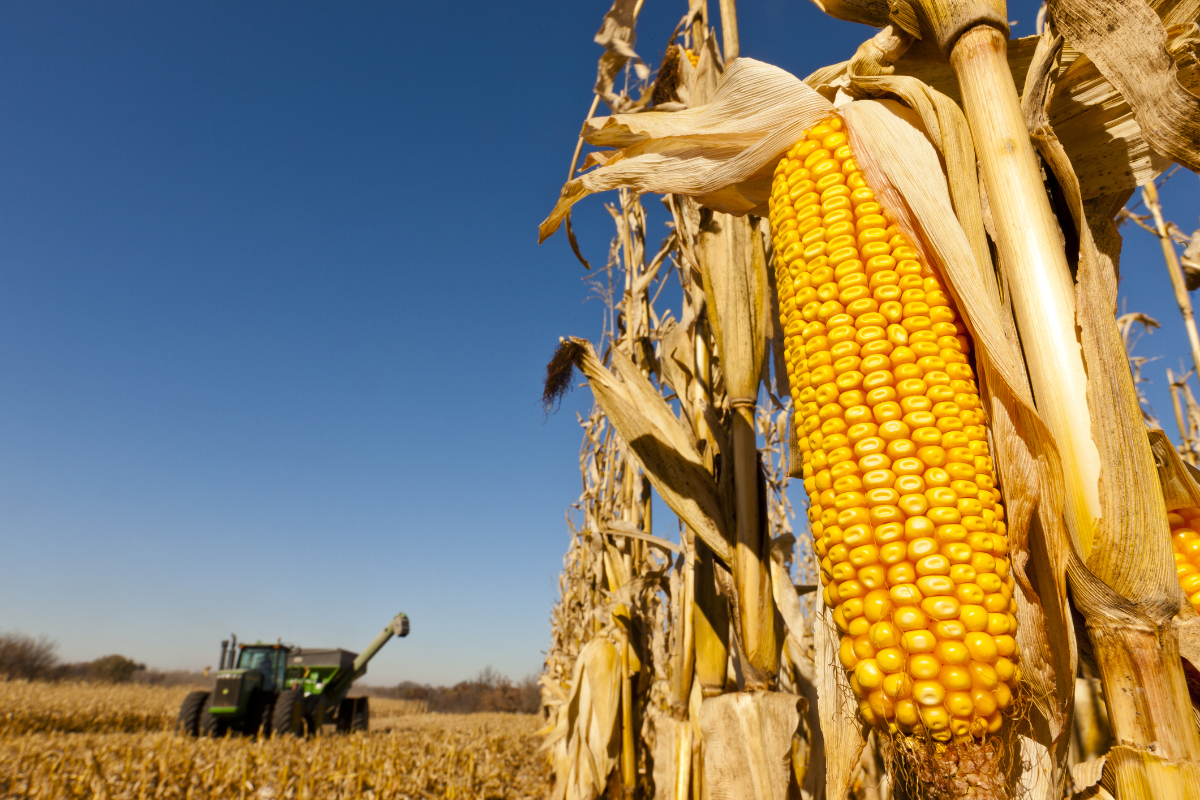The U.S. is the world leader in biofuel production—generating 47 percent of global output over the last decade. The ten-fold expansion in ethanol production in the U.S. from 2002 to 2019 has been driven by the Renewable Fuel Standard (RFS), a federal program that since 2005 has required transportation fuel to contain a minimum volume of renewable fuels. So far, that has largely meant corn ethanol. Currently 98 percent of gasoline in the U.S. contains some ethanol, most commonly 10 percent, or E10.
For the last decade, ethanol has helped keep corn in high demand, and made it the most-planted U.S. crop. In fact, roughly 40 percent of all corn is now used to make ethanol. Meanwhile, the number of corn farms over 500 acres in size has increased over time, while the number of small corn farms is dwindling. And all this growth has led to record profits for the companies that buy and sell the nation’s corn. For instance, last month, Archer-Daniels-Midland, the food processing and commodities trading giant, reported its highest-ever earnings, a net income of over $2.7 billion, due in large part to rising biofuel demand.
For the last decade, ethanol has helped keep corn in high demand, and made it the most-planted U.S. crop. In fact, roughly 40 percent of all corn is now used to make ethanol.
Despite the promise that the RFS would reduce greenhouse gas emissions, a new study published in the journal Proceedings of the National Academy of Science (PNAS) today finds that expansion of U.S. corn cultivation has come at eye-popping environmental costs. Corn production expanded by 8.7 percent, or 2.8 million hectares (6.9 million acres), between 2008 and 2016. As a result, the researchers found that nationwide annual fertilizer use surged by 3 to 8 percent and water pollutants rose by 3 to 5 percent. The sheer extent of domestic land use change, however, generated greenhouse gas emissions that are, at best, equivalent to those caused by gasoline use—and likely at least 24 percent higher.
That’s because the RFS caused corn prices to spike by 30 percent and soybean and other crops by 20 percent. As a result, farmers planted corn everywhere they could, replacing other crops and pastureland, and plowing up land that had previously been reserved for conservation purposes. They also often skipped the soybeans in their rotations, despite the potential impacts on their soil.
Tyler Lark, who studies land use change at the University of Wisconsin at Madison, has been tracking cropland expansion for years, but the burning research question in his field has been: To what degree have biofuels driven that expansion? Lark teamed up with agricultural economists and water quality experts for five years to produce what is one of the most comprehensive studies to date.
The bottom line is bluntly straightforward. “If you crank up demand, you get land use change,” says Lark, who is also a co-author of the new study. Every major agency in the U.S. that puts out data, including the U.S. Department of Agriculture (USDA), the U.S. Geological Survey (USGS), and the Environmental Protection Agency (EPA) have all observed this rapid cropland expansion, adds Lark.
Previous studies, however, dramatically underestimated the impacts those land use changes had on carbon emissions; in fact, the models treated the land that was converted from conservation or pasture as if there was little change in the amount of carbon stored once it was planted with corn—which runs counter to existing empirical evidence.
The new study comes at a crucial moment. This year, the Biden administration will reset the biofuel volume targets of the RFS, and it’s yet to be seen how new targets could ultimately impact the price of corn, demand for soybeans to make biodiesel, the farms that produce these crops, and—ultimately—the dead zone in the Gulf of Mexico.
Plowing up Carbon
Lark’s findings are the latest evaluation of the hotly contested biofuel carbon footprint. Several disparate data sources have confirmed the overall trend of grassland-to-cropland conversion in recent years, but researchers have used many different methodologies and assumptions to analyze that footprint over the years, leading to divergent estimates of greenhouse gas emissions resulting from the RFS.
The current study used the survey-based USDA National Resources Inventory (NRI), which had been endorsed previously by the Renewable Fuels Association, a trade association for the ethanol industry, to quantify cropland expansion area and the portion attributable to corn ethanol. Still, the organization criticized the findings.
“The claims in this report simply don’t align with reality and the facts on the ground. By slapping together a series of worst-case assumptions, cherry-picked data, and disparate results from previously debunked studies, the authors created a completely fictional and erroneous account of the environmental impacts of the Renewable Fuel Standard,” said Geoff Cooper, president and CEO of the Renewable Fuels Association in the statement responding to the study. (Requests for comment from the National Corn Growers Association and the Iowa Renewable Fuels Association were not returned.)
The Conservation Reserve Program (CRP), which pays farmers to keep some of their land uncultivated, saw the acreage in the program decrease precipitously after 2007 as farmers capitalized on high corn prices. The CRP is now at its lowest enrollment in over 30 years.
Given the differing estimates of greenhouse gas impacts, Jeremy Martin, director of fuels policy at the Union of Concerned Scientists (UCS), doesn’t think asking whether corn ethanol is better or worse than gasoline is the most important question. “I don’t think that biofuels are going to go away. But clearly they’ve had an impact on water quality and fertilizer usage—which are important findings to consider when setting future biofuels policies,” he says. He suggests a more relevant question is: How many acres of corn can farms plant while still meeting water quality or conservation goals?
The federal Conservation Reserve Program (CRP), which pays farmers to keep some of their land uncultivated, saw the acreage in the program decrease precipitously after 2007 as farmers chose to capitalize on high corn prices. As a result, the carbon storage gained via the CRP was lost to the atmosphere. And now, the CRP is at its lowest enrollment in over 30 years—while the USDA just announced it plans to spend $1 billion to encourage carbon sequestration in soil.

Image courtesy of Silvia Secchi. Read about the difference between Conservation Reserve Program (CRP) enrollment and general CRP enrollment.
Ethanol critics say this study suggests what some have long suspected—that the RFS is a tool to prop up corn prices. “If this paper is discounted [in RFS deliberations], or we fail to acknowledge the net greenhouse gas effect of corn ethanol, we will be admitting this policy is all about income support for farmers,” says Silvia Secchi, a natural resource economist at the University of Iowa.
















Carry on your good work.
Ridge
And this article does not even get into the huge biodiversity harms caused by corn and beans (and other) monocultures or bicultures, and their heavy dependence on pesticides and lack of diverse habitat.
But you are right that farmers are not the primary culprits, but rather the large companies like Cargill, JPS, ADM, Monsanto/Bayer, and retailers like Walmart, etc. and the harmful policies and economic incentives they drive that are the real causes. Farmers are mostly caught in the middle. Often they struggle with overproduction and subsequent prices below the cost of production.
However, farmers ultimately contribute to the problem with defensive statements that ignore or distort the science, whether about nitrogen fertilizer (and phosphorus) and water pollution or climate change. Those farmers, allied with others, could be a force for positive change. But instead, the big companies, that have been making excessive profits at their expense, are laughing all the way to the bank.
We need fundamental change in how we farm, based on agroecology and food sovereignty, that supports and works for farmers, rural communities that are also hurting, and the environment and eaters. Farmers could be a real voice for that change, but often instead let the big corporations direct the agenda to their own (and everyone else's) long-term detriment.
Because Typha is classified as one of the most obnoxious weeds known to agriculture, agricultural runoff carefully furrowed to drain into acreage planted with the cat tail reed would be almost too much, making water and fertilizer inputs unnecessary.
Along with economic amounts of starch for ethanol production, downstream issues of toxic algae outbreaks and oxygen dead zones in the Gulf of Mexico would be resolved.
Government ag policy could be much improved to encourage (or, God forbid, mandate) conservation measures and regenerative farming. Corn production would still occur with good farm policy. Just doing a smell test, ethanol is not polluting more than gasoline or any part of the fossil fuel industry including electricity generated from coal or natural gas and minerals mined for batteries with diesel powered equipment. I empathize with the sentiment that we are not doing the climate any favors by how we live but let's prioritize the problems properly. The oil industry is at the top of the bad problem list. Even without another sponsored study that computes.